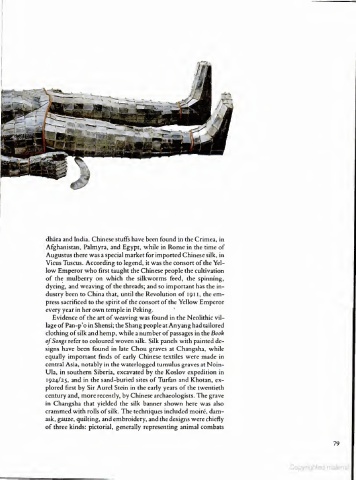Page 99 - The Arts of China, By Michael Sullivan Good Book
P. 99
dhara and India. Chinese stuffs have been found in the Crimea, in
Afghanistan, Palmyra, and Egypt, while in Rome in the time of
Augustus there was a special market for imported Chinese silk, in
Vicus Tuscus. According to legend, it was the consort of the Yel-
low Emperor who first taught the Chinese people the cultivation
of the mulberry on which the silkworms feed, the spinning,
dyeing, and weaving of the threads; and so important has the in-
dustry been to China that, until the Revolution of lyi 1, the em-
press sacrificed to the spirit of the consort of the Yellow Emperor
every year in her own temple in Peking.
Evidence of the art of weaving was found in the Neolithic vil-
lage of Pan-p'o in Shensi; the Shang people at Anyang had tailored
clothing of silk and hemp, while a number of passages in the Book
of Songs refer to coloured woven silk. Silk panels with painted de-
signs have been found in late Chou graves at Changsha, while
equally important finds of early Chinese textiles were made in
central Asia, notably in the waterlogged tumulus graves at Noin-
Ula, in southern Siberia, excavated by the Koslov expedition in
1924/25, and in the sand-buried sites of Turfan and Khotan, ex-
plored first by Sir Aurel Stein in the early years of the twentieth
century and, more recently, by Chinese archaeologists. The grave
in Changsha that yielded the silk banner shown here was also
crammed with rolls of silk. The techniques included moire, dam-
ask, gauze, quilting, and embroidery, and the designs were chiefly
of three kinds: pictorial, generally representing animal combats

